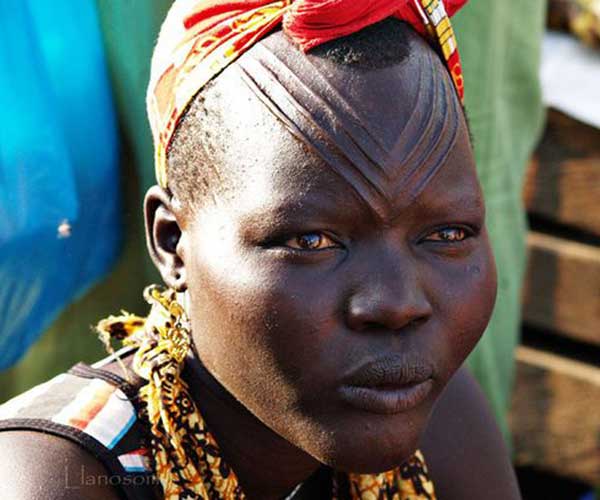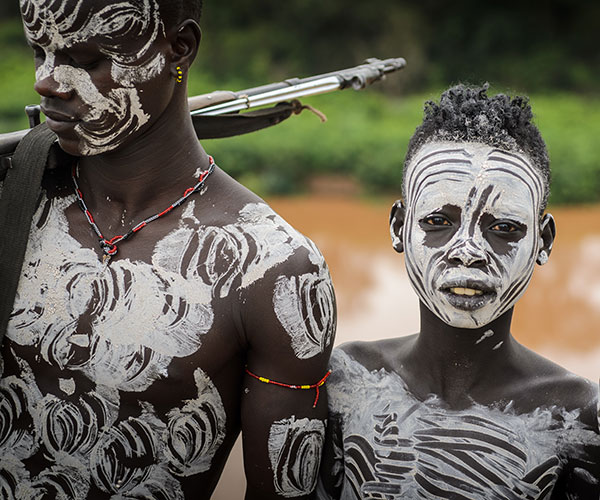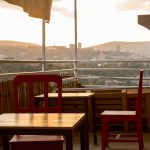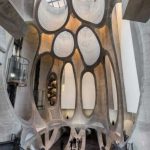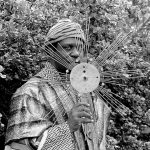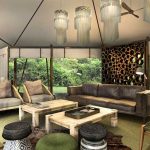MEET THE ANCIENT TRIBES ALONG THE OMO RIVER
Until recent years, the tribes of the Omo River basin in the remote south-west of Ethiopia had not even heard of the nation of which they were a part. For all they knew, Addis Ababa might have been the dark side of the moon.

Theirs is a traditional world. The men count their wealth in cattle, their wives in goats, and their status by the number of enemies they have murdered. They paint their bodies for war and celebration, and drink cow’s blood to revive their spirits. The women, among the most beautiful in Africa, scar their torsos in elaborate patterns for erotic effect, and in preparation for marriage, insert plates the size of frisbees into their lower lips.
“This is what one dreamt about as a child”, a seasoned African traveller told me once. “An Africa untouched by our own culture.”
Ethiopia is a museum of peoples, a rich and varied mix of ethnicities with 83 different languages and over 200 dialects. But even in this crowded cultural mosaic, the tribal diversity of the Omo River Basin is unparalleled: the Hamar, the Konso, the Borana, the Bumi, the Surma, the Anuak, the Nuer and the Bodi all belong to the world of ‘primitive’ Africa. Some like the Morsi – the subject of recent documentaries – have grown rapacious after contact with outsiders. Others like the Karo, who number only about 1,000 souls, may be heading for extinction. A few have never seen a white face. Most are cattle people or pastoralists who maintain huge herds of pale, long-horned cows, too precious to be butchered for food. They lack almost any form of material culture beyond personal adornment, yet they inhabit a richly symbolic universe.

Tribal warfare is a way of life in these regions, and cattle raids and killings are part of the initiation of any young man of good family. Like notches on a gun belt, horseshoe-shaped scars on the upper arms of Mursi or Bodi warriors mark the number of their victims. Serial killers are sought after as husbands.
The Omo is oddly reminiscent of the American West in the nineteenth century: life revolves around cattle, gunplay, and getting the girl. Only the guns are different. In the Omo, AK47’s are de rigeur. Of all the modern technologies that the world has to offer these peoples, the only one to make an impact is the automatic rifle.
With a small but motley crew, I headed south from Addis Ababa. The central highlands of Ethiopia are a dense, agrarian landscape, quite unlike the Omo basin. The people are serious and hardworking; the women keep their tops on; and the middle classes are distinguished by umbrellas.
Between tangled walls of maize and false bananas, the road was swollen with pedestrian traffic. Young men strolled arm-in-arm, while women staggered in their wake beneath vast sacks. Girls in white shawls made their way home from school. A few horsemen passed: glamorous figures with long whips and wide-brimmed straw hats. A priest appeared beneath a splendid parasol. Nestled among the crops were round thatched tukuls. Traditional architecture is circular here – and in the flyblown towns, full of tea and tyre shops, square huts with corrugated roofs were a sign of decadent modernity.

We spent a night at Jimma, where taxis were donkey chariots driven by eight-year-olds; then moving on to Kaffe, where we slept among the topiary hedges of a government coffee plantation. As we pushed west and south, the road became rougher; the vegetation wilder; the faces blacker; the clothes more bedraggled; and the smiles wider.
On the third day, somewhere beyond Dimma, we began to drop out of the highlands. The fields and the villages fell away. The hills unravelled. The views lengthened. Breaking free of its confinement, the landscape was spilling out on all sides towards distant escarpments. We were falling into an empty world of savannah and acacia. Long waves of grass commandeered the horizons.
After the crowded uplands, the emptiness of this new country was almost unnerving. The land shimmered in lowland heat. A sentinel figure appeared, on a rock above the road, silhouetted against a pewter sky – a tall, naked tribesman with a spear: the archetypal image of Africa, like a guardian on the frontier of a new world.

We were entering the lands of the Surma, one of the largest tribes west of the Omo. After that first figure, others appeared: boys herding goats; men melting away into the grass; a young woman naked in a river.
In the late afternoon, we arrived at Tulget, a Surma settlement straddling a long ridge. Few things were as novel as white folk in a car, so naturally the whole village immediately dropped what they were doing to get a good look at us. Men with spectacular, elongated earlobes and women with huge lip plates crowded round to gaze at us as if we were circus freaks. I knew they were dying to poke us. They giggled behind their hands at our pale skin, our watery eyes, our bizarre clothing. In this barefoot, bare-assed and bare-breasted company, I felt I had arrived a trifle overdressed.
We pitched our camp in the grounds of the mission church, watched by hordes of spectators. Later, when I went for a stroll through the village, I came upon a woman sitting on a log outside her house. She was stretching her lower lip with a mixture of charcoal and butter. In all the sad history of crippling female adornment, from bound feet to suffocating corsets, nothing quite compares to the lip plate worn by the Surma and the Morsi women of the Omo Basin.
It seemed the moment to broach this delicate issue. But I was keen not to cause offence. I didn’t want to let on that it was the sheer hideousness of the plate that fascinated me. At first I thought I might try, “Hey, love your lip plate. Do the fellows in your tribe find that as much of a turn-on as I do?” In the end I settled for the neutral brevity of “why?”

Women do not insert the lip plate until they are preparing for marriage in their early twenties. An incision is made in the lower lip, which is stretched over a period of months to accommodate a plate made of baked clay or wood. The two front lower teeth usually need to be extracted to make fitting easier. The plates are worn, rather like a veil in Islamic societies, in the presence of men. At home and in the company of other women, they tend to take the plates out and let the stretched lower lip dangle down below the chin in picturesque fashion. Older women eventually abandon their plates, while fashion-conscious young wives don’t like to be seen without them.
One theory is that the plate was an anti-slaving device: a way of making your tribe unappealing to Arab slave traders from the coast; another is that it is a protection against evil spirits, which are said to enter the body through the mouth. But the girl herself, working on her own lip in the dusk, said that it was chiefly a question of goats. The larger the lip plate, the more goats her father could demand from prospective bridegrooms for her hand in marriage. In these societies, marriage is a kind of pension fund: you pay for a big lip plate on your wife when you are young in the hope that you will have plenty of daughters with decent lip plates to sell in your old age.

A couple of days later, we were in the lands of the Karo staying at a lodge at Murle on the east bank of the river. In the afternoon, we walked up to Kolcho, a Karo village. Termite towers rose from the savannah. We skirted a lake where tropical bou-bou birds were singing duets. In the woods nearby, families of colobus monkeys were quarrelling. On a low ridge, we arrived at the village with flocks of goats returning to their family corrals for the night.
There was a dance at sunset. The warriors appeared, their bodies decorated with white markings. They assembled in a half-circle under a rising moon. The women clustered nearby, wearing thick, bundled necklaces and skirts of oiled skins. With elaborate hand-clapping rhythms and deep, mesmeric chants, the men took turns leaping into the air. The women, too, began clapping; and one-by-one, they danced forward to select a man of their choice from the line. Amidst rising clouds of dust, the couples thrust their hips at one another in a pantomime of sex. It was erotic, but also happily innocent, full of laughter and teasing.
A trio of new women arrived on the periphery to watch the dance. Amongst the animals skins, the arm bands and the long strings of beads, they had a startling item of clothing: brassieres. They had been to Addis; they had seen the future… And now they were wearing it.
In this place, they seemed oddly indecent.
 Stanley Stewart is the author of three highly acclaimed travel books and several-hundred articles based on journeys across five continents, for which he has won numerous journalism awards. He is a contributing editor of Condé Nast Traveller and his work appears regularly in the Sunday Times. He has also contributed to the Daily Telegraph, the Guardian, the Independent and the Times. He writes for the National Geographic Traveler in the US, the Sunday Times in South Africa and the Australian.
Stanley Stewart is the author of three highly acclaimed travel books and several-hundred articles based on journeys across five continents, for which he has won numerous journalism awards. He is a contributing editor of Condé Nast Traveller and his work appears regularly in the Sunday Times. He has also contributed to the Daily Telegraph, the Guardian, the Independent and the Times. He writes for the National Geographic Traveler in the US, the Sunday Times in South Africa and the Australian.






